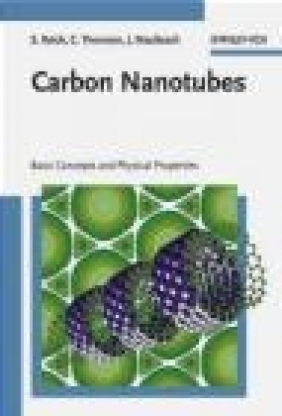Carbon Nanotubes
Christian Thomsen, Janina Maultzsch, Stephanie Reich
Carbon Nanotubes
Christian Thomsen, Janina Maultzsch, Stephanie Reich
- Producent: VCH
- Rok produkcji: 2004
- ISBN: 9783527403868
- Ilość stron: 224
- Oprawa: Twarda
Niedostępna
Opis: Carbon Nanotubes - Christian Thomsen, Janina Maultzsch, Stephanie Reich
Carbon nanotubes are exceptionally interesting from a fundamental research point of view. Many concepts of one-dimensional physics have been verified experimentally such as electron and phonon confinement or the one-dimensional singularities in the density of states; other 1D signatures are still under debate, such as Luttinger-liquid behavior. Carbon nanotubes are chemically stable, mechanically very strong, and conduct electricity. For this reason, they open up new perspectives for various applications, such as nano-transistors in circuits, field-emission displays, artificial muscles, or added reinforcements in alloys. This text is an introduction to the physical concepts needed for investigating carbon nanotubes and other one-dimensional solid-state systems. Written for a wide scientific readership, each chapter consists of an instructive approach to the topic and sustainable ideas for solutions. The former is generally comprehensible for physicists and chemists, while the latter enable the reader to work towards the state of the art in that area. The book gives for the first time a combined theoretical and experimental description of topics like luminescence of carbon nanotubes, Raman scattering, or transport measurements. The theoretical concepts discussed range from the tight-binding approximation, which can be followed by pencil and paper, to first-principles simulations. We emphasize a comprehensive theoretical and experimental understanding of carbon nanotubes including - general concepts for one-dimensional systems - an introduction to the symmetry of nanotubes - textbook models of nanotubes as narrow cylinders - a combination of ab-initio calculations and experiments - luminescence excitation spectroscopy linked to Raman spectroscopy - an introduction to the 1D-transport properties of nanotubes - effects of bundling on the electronic and vibrational properties and - resonance Raman scattering in nanotubes. "This book is...of interest to a wide range of scientists and graduate students in material science." (IEEE Circuits & Devices, July/August 2006) "This little-over-200-page book is well organized with each chapter beginning with a brief introduction and ending with a short summary...physicists, chemists, and material scientists who do research in this field will also find this book useful..." (E-STREAMS, October 2004) "The book gives for the first time a combined theoretical and experimental description of fundamental topics..." (Polymer News) "...physical concepts needed to understand and investigate carbon nanotubes are introduced..." (Materials Today, June 2004) "There is considerable theoretical discussion that would be of value to graduate students and researchers inside this book's pages." (Chip Scale Review, July 2004, (online: May 17, 2004))Preface. 1 Introduction. 2 Structure and Symmetry. 2.1 Structure of Carbon Nanotubes. 2.2 Experiments. 2.3 Symmetry of Single-walled Carbon Nanotubes. 2.3.1 Symmetry Operations. 2.3.2 Symmetry-based Quantum Numbers. 2.3.3 Irreducible representations. 2.3.4 Projection Operators. 2.3.5 Phonon Symmetries in Carbon Nanotubes. 2.4 Summary. 3 Electronic Properties of Carbon Nanotubes. 3.1 Graphene. 3.1.1 Tight-binding Description of Graphene. 3.2 Zone-folding Approximation. 3.3 Electronic Density of States. 3.3.1 Experimental Verifications of the DOS. 3.4 Beyond Zone Folding - Curvature Effects. 3.4.1 Secondary Gaps in Metallic Nanotubes. 3.4.2 Rehybridization of the sigma and pi States. 3.5 Nanotube Bundles. 3.5.1 Low-energy Properties. 3.5.2 Visible Energy Range. 3.6 Summary. 4 Optical P roperties. 4.1 Absorption and Emission. 4.1.1 Selection Rules and Depolarization. 4.2 Spectra of Isolated Tubes. 4.3 Photoluminescence Excitation - (n1, n2) Assignment. 4.4 4-A-diameter Nanotubes. 4.5 Bundles of Nanotubes. 4.6 Excited-state Carrier Dynamics. 4.7 Summary. 5 Electronic Transport. 5.1 Room-temperature Conductance of Nanotubes. 5.2 Electron Scattering. 5.3 Coulomb Blockade. 5.4 Luttinger Liquid. 5.5 Summary. 6 Elastic Properties. 6.1 Continuum Model of Isolated Nanotubes. 6.1.1 Ab-initio, Tight-binding, and Force-constants Calculations. 6.2 Pressure Dependence of the Phonon Frequencies. 6.3 Micro-mechanical Manipulations. 6.4 Summary. 7 Raman Scattering. 7.1 Raman Basics and Selection Rules. 7.2 Tensor Invariants. 7.2.1 Polarized Measurements. 7.3 Raman Measurements at Large Phonon q. 7.4 Double Resonant Raman Scattering. 7.5 Summary. 8 Vibrational Properties. 8.1 Introduction. 8.2 Radial Breathing Mode. 8.2.1 The RBM in Isolated and Bundled Nanotubes. 8.2.2 Double-walled Nanotubes. 8.3 The Defect-induced D Mode. 8.3.1 The D Mode in Graphite. 8.3.2 The D Mode in Carbon Nanotubes. 8.4 Symmetry of the Raman Modes. 8.5 High-energy Vibrations. 8.5.1 Raman and Infrared Spectroscopy. 8.5.2 Metallic Nanotubes. 8.5.3 Single- and Double-resonance Interpretation. 8.6 Summary. 8.7 What we Can Learn from the Raman Spectra of Single-walled Carbon Nanotubes. Appendix A: Character and Correlation Tables of Graphene. Appendix B: Raman Intensities in Unoriented Systems. Appendix C: Fundamental Constants. Bibliography. Index.
Szczegóły: Carbon Nanotubes - Christian Thomsen, Janina Maultzsch, Stephanie Reich
Tytuł: Carbon Nanotubes
Autor: Christian Thomsen, Janina Maultzsch, Stephanie Reich
Producent: VCH
ISBN: 9783527403868
Rok produkcji: 2004
Ilość stron: 224
Oprawa: Twarda
Waga: 0.54 kg




























